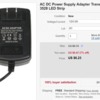Hi,
Assume I have a large accessory, which needs DC power. And, the box says that the accessory is X watts, and Y volts.
Assume I want to buy a dedicated DC power pack to run this accessory only. (AC input only, DC output only.)
How to I choose the power pack? Do I buy one that says it is X watts, or do I buy one that says it is Y volts? Or both?
I don't want to buy a power source that has a throttle on it, but maybe I have to, and then just carefully turn up the throttle until the accessory works?
Or perhaps I have to match amps somehow? But, no DC accessories I typically see ever list amps. And, many power packs and transformers (rectifiers) don't list amps on the unit.
Thanks for all help and advice.
Mannyrock










